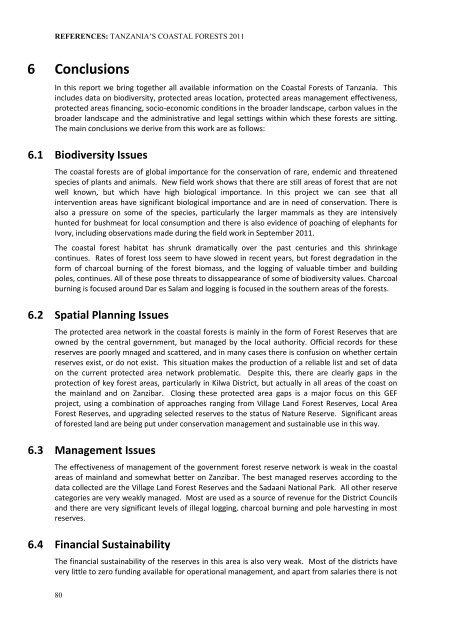Neil D. Burgess, Paul Harrison, Peter Sumbi, James Laizer, Adam ...
Neil D. Burgess, Paul Harrison, Peter Sumbi, James Laizer, Adam ...
Neil D. Burgess, Paul Harrison, Peter Sumbi, James Laizer, Adam ...
You also want an ePaper? Increase the reach of your titles
YUMPU automatically turns print PDFs into web optimized ePapers that Google loves.
REFERENCES: TANZANIA’S COASTAL FORESTS 2011<br />
6 Conclusions<br />
In this report we bring together all available information on the Coastal Forests of Tanzania. This<br />
includes data on biodiversity, protected areas location, protected areas management effectiveness,<br />
protected areas financing, socio-economic conditions in the broader landscape, carbon values in the<br />
broader landscape and the administrative and legal settings within which these forests are sitting.<br />
The main conclusions we derive from this work are as follows:<br />
6.1 Biodiversity Issues<br />
The coastal forests are of global importance for the conservation of rare, endemic and threatened<br />
species of plants and animals. New field work shows that there are still areas of forest that are not<br />
well known, but which have high biological importance. In this project we can see that all<br />
intervention areas have significant biological importance and are in need of conservation. There is<br />
also a pressure on some of the species, particularly the larger mammals as they are intensively<br />
hunted for bushmeat for local consumption and there is also evidence of poaching of elephants for<br />
Ivory, including observations made during the field work in September 2011.<br />
The coastal forest habitat has shrunk dramatically over the past centuries and this shrinkage<br />
continues. Rates of forest loss seem to have slowed in recent years, but forest degradation in the<br />
form of charcoal burning of the forest biomass, and the logging of valuable timber and building<br />
poles, continues. All of these pose threats to dissappearance of some of biodiversity values. Charcoal<br />
burning is focused around Dar es Salam and logging is focused in the southern areas of the forests.<br />
6.2 Spatial Planning Issues<br />
The protected area network in the coastal forests is mainly in the form of Forest Reserves that are<br />
owned by the central government, but managed by the local authority. Official records for these<br />
reserves are poorly mnaged and scattered, and in many cases there is confusion on whether certain<br />
reserves exist, or do not exist. This situation makes the production of a reliable list and set of data<br />
on the current protected area network problematic. Despite this, there are clearly gaps in the<br />
protection of key forest areas, particularly in Kilwa District, but actually in all areas of the coast on<br />
the mainland and on Zanzibar. Closing these protected area gaps is a major focus on this GEF<br />
project, using a combination of approaches ranging from Village Land Forest Reserves, Local Area<br />
Forest Reserves, and upgrading selected reserves to the status of Nature Reserve. Significant areas<br />
of forested land are being put under conservation management and sustainable use in this way.<br />
6.3 Management Issues<br />
The effectiveness of management of the government forest reserve network is weak in the coastal<br />
areas of mainland and somewhat better on Zanzibar. The best managed reserves according to the<br />
data collected are the Village Land Forest Reserves and the Sadaani National Park. All other reserve<br />
categories are very weakly managed. Most are used as a source of revenue for the District Councils<br />
and there are very significant levels of illegal logging, charcoal burning and pole harvesting in most<br />
reserves.<br />
6.4 Financial Sustainability<br />
The financial sustainability of the reserves in this area is also very weak. Most of the districts have<br />
very little to zero funding available for operational management, and apart from salaries there is not<br />
80

















